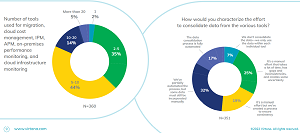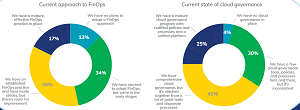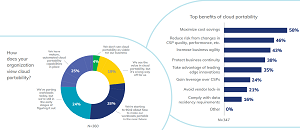News
Multi-Cloud Study Shows Complexity, Tool Sprawl, Siloed Data Challenges
A new report reaffirms the huge growth in multi-cloud implementations while also detailing challenges concerning complexity, tool sprawl, siloed data and more.
Those details come in the State of Multi-Cloud Management survey-based report from hybrid cloud management and monitoring specialist Virtana, which found that enterprises plan to grow their multi-cloud environments in 2022, with 82 percent of organizations currently leveraging a multi-cloud strategy and 78 percent having workloads deployed in more than three public clouds.
"Given the pandemic-induced wave of remote work, it was not surprising to see that the number of respondent organizations with over half of their workloads in the public cloud grew 75 percent in the last 13 months," Virtana said. "And that 51 percent plan to increase their number of public cloud instances by the end of 2022."
Other key findings of the report include:
-
Tool sprawl and siloed data impede transformation:
- 63 percent of respondents are using more than five tools for migration, cloud cost optimization, IPM, APM and cloud infrastructure monitoring.
- 83 percent are expending some level of manual effort to consolidate data from all of these tools, or they're just using the tools separately.
- 53 percent of organizations using 20+ tools still have manual processes, and 6 percent aren't consolidating the data at all.
- 73 percent stated that siloed efforts limit their ability to realize the full potential of the cloud.
"Organizations use a variety of tools to monitor and manage different aspects of their complex hybrid, multi-cloud environments," Virtana said. "There are tools for migration, cloud cost optimization, IPM, APM, cloud infrastructure monitoring and more.
 [Click on image for larger view.] Tool Sprawl (source: Virtana).
[Click on image for larger view.] Tool Sprawl (source: Virtana).
"In and of itself, this isn't necessarily a problem as each of these tools provides a specific important function. The challenge is that if you can't consolidate data from all these different tools, you cannot get a comprehensive and complete view of your infrastructure. This lack of global visibility creates gaps that can expose you to performance, cost and other risk. But consolidating all of that data is not easy."
-
Cloud deployment may be widespread, but formal controls are not:
- While the vast majority -- 87 percent -- agree that there's value in FinOps, it's still early days as 70 percent have started but have not yet developed a mature practice.
- Likewise, 75 percent are lacking cloud governance to guide cloud management despite the fact that 96 percent see it as valuable.
"The prevalence of hybrid, multi-cloud infrastructures and the high cloud costs they entail -- not to mention the strategic importance to digital transformation and competitiveness -- might lead one to assume that enterprises would have solid cost and governance controls in place," Virtana said. "While there's a lot of industry buzz around FinOps (cross-functional ownership to bring financial accountability to the variable spend model of the cloud, enabling all teams to make business trade-offs between speed, cost and quality) and cloud governance (framework of mechanisms, processes and relations used by various parties to control and to operate a cloud environment), it seems at this point to be more talk than action."
 [Click on image for larger view.] Lack of Formal Controls (source: Virtana).
[Click on image for larger view.] Lack of Formal Controls (source: Virtana).
-
Management capabilities are evolving, but technology is changing and there are challenges to overcome:
- 96 percent of respondents see value in workload portability, but 71 percent are only in the early stages, with the top benefits anticipated to be maximized cost savings (58 percent), reduced cloud service provider (CSP) risk (46 percent) and increased business agility (43 percent).
- 95 percent see value in serverless computing, but 76 percent are only in the early stages, and the top benefits cited are increased scalability (55 percent) and reduced cost (54 percent).
"Given the complexities of hybrid, multi-cloud environments, organizations will look for new ways to improve their management capabilities," Virtana said. "Two approaches -- workload portability and serverless computing -- are starting to gain ink in the industry, but are they gaining traction in practice within enterprise infrastructures? Let's start with workload portability, which is the ability to easily move workloads between on-premises systems and across multiple CSPs. The vast majority (96 percent) of respondents said they see value in workload portability, but for most (71 percent) it's not yet an operational reality. When asked about the top benefits they anticipate cloud portability will deliver, respondents are primarily looking to maximize cost savings (58 percent); reduce risk from changes in CSP quality, performance, etc. (46 percent); and increase business agility (43 percent).
 [Click on image for larger view.] Management Capabilities/Challenges (source: Virtana).
[Click on image for larger view.] Management Capabilities/Challenges (source: Virtana).
"This year, organizations are reimagining hybrid cloud strategies and processes and are realizing that in order to maximize the benefits of the cloud they must first understand that unified visibility and simplified management are critical to controlling cost and risk -- paving the way for true business transformation," said Jonathan Cyr, VP of product management for Virtana.
The survey was conducted by an independent research firm, polling 360 cloud decision-makers in the U.S. and the UK during February and March 2022. Respondents were verified and randomized using global panel service providers, and all surveys were completed online. The margin of error for the study is +/- 5.2 percent at the 95 percent confidence level.
About the Author
David Ramel is an editor and writer for Converge360.